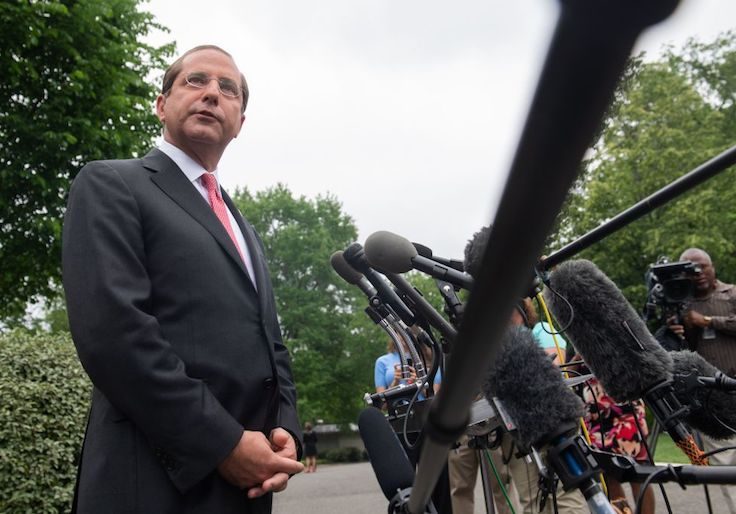The Trump administration will soon begin accepting proposals for pilot programs to import prescription drugs from Canada, the Department of Health and Human Services announced Wednesday.
The new policy is the administration's latest move aimed at reducing sky-high drug prices. But it is likely to inflame long-standing tensions, as supporters of importation clash with those who fear it could threaten the integrity of America's pharmaceutical supply chain.
The high cost of prescription drugs in the United States has become a bipartisan concern. Americans spend more than every other OECD country on prescription drugs. Particularly important drugs, such as insulin, have seen conspicuous price spikes in recent years, exacerbating citizens' concerns about how much they have to spend on their health.
"President Trump has been clear: for too long American patients have been paying exorbitantly high prices for prescription drugs that are made available to other countries at lower prices," HHS Secretary Alex Azar said. "Today's announcement outlines the pathways the Administration intends to explore to allow safe importation of certain prescription drugs to lower prices and reduce out of pocket costs for American patients."
Why, exactly, the United States pays such a premium on prescription drugs is complicated. The recent spike is in large part due to advancement in complex, many-molecule drugs called biologics. For example, the 2014 introduction of biologic drugs for treating Hepatitis C, such as Harvoni, is a major contributor. The adaptation of America's regulatory framework for generic versions of biologic drugs — and the production of what are called biosimilars — is still in its infancy.
Other countries have not experienced the same price increases attributable to name brand biologics. That's in large part due to government control — unlike other countries, the United States does not directly or indirectly control drug prices. Nor does it have a monopsony health care system, which would wield enormous bargaining power. As such, pharmaceutical firms charge higher prices in the United States than in other countries, using the U.S. market to make up for lost profits in Europe, Canada, and other developed nations.
The goal of drug importation, in the view of proponents, is to undo this imbalance, by allowing foreign-priced drugs to flow into American markets. The administration's new plan does not lay out a way to accomplish this goal directly; rather, it outlines two "pathways" by which states, wholesalers, pharmacists, and pharmaceutical firms could bring foreign drugs into the country.
"Pathway one" would use the FDA's preexisting statutory authority to permit pilot programs to test the efficacy of importation from Canada. States, wholesalers, and pharmacists would submit proposals to HHS to import drugs approved by Canada's drug authority and equivalent to previously FDA-approved drugs. Certain kinds of drugs, including controlled substances, would be excluded. Proposals would also need to meet "track and trace" requirements to ensure the integrity of the drugs from manufacture to sale.
"Pathway two" would allow pharmaceutical firms to import drugs originally made for foreign markets into the United States, and sell them at foreign prices. According to HHS, firms might take advantage of this pathway to cut drug prices imposed on them by preexisting contracts in the U.S. market. Industry associations PhRMA and BIO are opposed to this approach.
Both of these programs are likely to have a small effect on drug costs, at least until the results of pathway one pilots are available for analysis. But they are also likely to be overwhelmingly popular: 80 percent of Americans support importing prescription drugs from Canada.
This sort of popularity makes drug importation an obvious prescription, especially in an election year. It also may drown out the concerns of opponents of drug importation. Many experts are enormously concerned about the prospect of addressing America's drug price crisis with importation.
"We believe that such importation represents a complex and risky approach—one that the evidence shows will not achieve the aim, and that is likely to harm patients and consumers and compromise the carefully constructed system that guards the safety of our nation's medical products," four former FDA commissioners wrote in a 2017 letter to Congress.
Their concerns stem from the unique nature of the market in medicine, which almost definitionally has low-information consumers; people take the pills their doctors tell them to with little to no knowledge of what they might be doing to their bodies. To address safety concerns produced by this reality, the FDA runs a "closed" system of drug production, carefully tracking manufacturing practices through the entire supply chain. Opening this supply chain risks losing the FDA's standards of oversight.
This concern is exacerbated by the particular circumstances of Canada as a source for drugs. The Canadian market is an order of magnitude smaller than that of the United States, yet is already facing mass shortages. Canadian health officials have said they would be unable to meet U.S. demand.
This means in practice that Canadian drugs would mostly be imported through Canada, rather than made there — meaning that they may come from markets with poor regulatory oversight, such as India or China. The effects of low-quality imports have already been felt: in 2008, 150 people were killed by contaminated Heparin (a blood thinner), eventually traced to a Chinese manufacturer. Transshipment through Canada would also likely make America's northern neighbor a vector for illicit drug distribution, which is why many law enforcement experts oppose importation.
Concerns like these may explain why the administration is taking a pilot-program approach to importation at present. Whether any state or private actor will be able to create a system that meets federal—and consumer—standards for safety remains to be seen.
